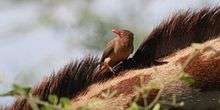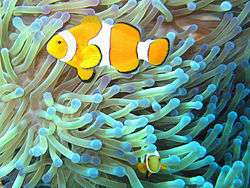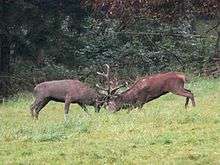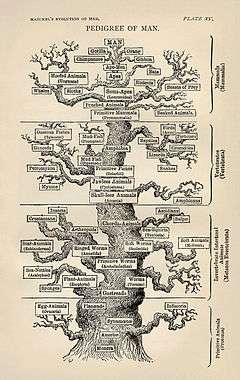Biological interaction
Biological interactions are the effects that the organisms in a community have on one another. In the natural world no organism exists in absolute isolation, and thus every organism must interact with the environment and other organisms. An organism's interactions with its environment are fundamental to the survival of that organism and the functioning of the ecosystem as a whole.[1]

In Ecology, biological interactions can involve individuals of the same species (intraspecific interactions) or individuals of different species (interspecific interactions). These can be further classified by either the mechanism of the interaction or the strength, duration and direction of their effects.[3] Species may interact once in a generation (e.g. pollination) or live completely within another (e.g. endosymbiosis). Effects range from consumption of another individual (predation, herbivory, or cannibalism), to mutual benefit (mutualism). Interactions need not be direct; individuals may affect each other indirectly through intermediaries such as shared resources or common enemies.
Interactions categorized by effect
| |||||||||||||||||||||
| Some types of relationships listed by the effect they have on each partner. '0' is no effect, '-' is detrimental, and '+' is beneficial. |
Terms that explicitly indicate the quality of benefit or harm in terms of fitness experienced by participants in an interaction are listed in the chart. There are six possible combinations, ranging from mutually beneficial through neutral to mutually harmful interactions. The level of benefit or harm is continuous and not discrete, so a particular interaction may have a range from trivially harmful through to deadly, for example. It is important to note that these interactions are not always static. In many cases, two species will interact differently under different conditions. This is particularly true in, but not limited to, cases where species have multiple, drastically different life stages.
Competition
Competition is a mutually detrimental interaction between individuals, populations or species, but rarely between clades.[4]
Amensalism
Amensalism is an interaction where an organism inflicts harm to another organism without any costs or benefits received by itself.[5] A clear case of amensalism is where sheep or cattle trample grass. Whilst the presence of the grass causes negligible detrimental effects to the animal's hoof, the grass suffers from being crushed. Amensalism is often used to describe strongly asymmetrical competitive interactions, such as has been observed between the Spanish ibex and weevils of the genus Timarcha which feed upon the same type of shrub. Whilst the presence of the weevil has almost no influence on food availability, the presence of ibex has an enormous detrimental effect on weevil numbers, as they consume significant quantities of plant matter and incidentally ingest the weevils upon it.[6]
Exploitation

In exploitative interactions, one species benefits at the expense of another. Predation is an interaction between organisms in which one organism captures biomass from another. It is often used as a synonym for carnivory but in its widest definition includes all forms of one organism eating another, regardless of trophic level (e.g., herbivory), closeness of association (e.g., parasitism and parasitoidism) and harm done to prey (e.g., grazing). Intraguild predation occurs when an organism preys upon another of different species but at the same trophic level (e.g., coyotes kill and ingest gray foxes in southern California). Batesian mimicry is also an exploitative interaction, where one species has evolved to mimic another, to the advantage of the copying species but to the detriment of the species being mimicked.
Neutralism
Neutralism describes the relationship between two species that interact but do not affect each other. It describes interactions where the health of one species has absolutely no effect whatsoever on that of the other. Examples of true neutralism are virtually impossible to prove and most ecologists (as well as textbooks) would agree that this concept does not exist.[7] When dealing with the complex networks of interactions presented by ecosystems, one cannot assert positively that there is absolutely no competition between or benefit to either species. However, the term is often used to describe situations where interactions are negligible or insignificant.
Synnecrosis is a particular case in which the interaction is so mutually detrimental that it results in death, as in the case of some parasitic relationships. It is a rare and necessarily short-lived condition as evolution selects against it. The term is seldom used.[8]
Ecological facilitation
The following two interactions can be classed as facilitative. Facilitation describes species interactions that benefit at least one of the participants and cause no harm to either.[9] Facilitations can be categorized as mutualisms, in which both species benefit, or commensalisms, in which one species benefits and the other is unaffected. Much of classic ecological theory (e.g., natural selection, niche separation, metapopulation dynamics) has focused on negative interactions such as predation and competition, but positive interactions (facilitation) are receiving increasing focus in ecological research.[9][10][11][12][13]
Commensalism
Commensalism benefits one organism and the other organism is neither benefited nor harmed. It occurs when one organism takes benefits by interacting with another organism by which the host organism is not affected. A good example is a remora living with a shark. Remoras eat leftover food from the shark. The shark is not affected in the process, as remoras eat only leftover food of the shark, which does not deplete the shark's resources.
Mutualism

Mutualism is an interaction between two or more species, where species derive a mutual benefit, for example an increased carrying capacity. Similar interactions within a species are known as co-operation. Mutualism may be classified in terms of the closeness of association, the closest being symbiosis, which is often confused with mutualism. One or both species involved in the interaction may be obligate, meaning they cannot survive in the short or long term without the other species. Though mutualism has historically received less attention than other interactions such as predation,[14] it is very important subject in ecology. Examples include cleaner fish, pollination and seed dispersal, gut flora, Müllerian mimicry and nitrogen fixation by bacteria in the root nodules of legumes.
Symbiosis

The term symbiosis (Greek: living together) can be used to describe various degrees of close relationship between organisms of different species. Sometimes it is used only for cases where both organisms benefit; sometimes it is used more generally to describe all varieties of relatively tight relationships, i.e. even parasitism, but not predation. Some even go so far as to use it to describe predation.[15] It can be used to describe relationships where one organism lives on or in another, or it can be used to describe cases where organisms are related by mutual stereotypic behaviors.
In either case, symbiosis is much more common in the living world and much more important than is generally assumed. Almost every organism has many internal parasites. A large percentage of herbivores have mutualistic gut fauna that help them digest plant matter, which is more difficult to digest than animal prey. Coral reefs are the result of mutalisms between coral organisms and various types of algae that live inside them. Most land plants and thus, one might say, the very existence of land ecosystems rely on mutualisms between the plants, which fix carbon from the air, and Mycorrhyzal fungi that help in extracting minerals from the ground. The evolution of all eukaryotes (plants, animals, fungi, protists) is believed to have resulted from a symbiosis between various sorts of bacteria: endosymbiotic theory.
Competition

Competition can be defined as an interaction between organisms or species, in which the fitness of one is lowered by the presence of another. Limited supply of at least one resource (such as food, water, and territory) used by both usually facilitates this type of interaction, although the competition may also exist over other 'amenities', such as females for reproduction (in case of male organisms of the same species).[14] Competition is one of many interacting biotic and abiotic factors that affect community structure. Competition among members of the same species is known as intraspecific competition, while competition between individuals of different species is known as interspecific competition.
Interspecific competition is normally not as fierce as intraspecific competition, unless in case of a sudden drastic change. However, it is the most conspicuous competition in grasslands, where, for example, cheetahs and hyenas are often killed by lion prides. Competition is not always a straightforward, direct interaction either, and can occur in both a direct and indirect fashion.
Competition between species at the same trophic level of an ecosystem, who have common predators, increases drastically if the frequency of the common predator in the community is decreased by a large margin. The magnitude of competition therefore depends on many factors in the same ecosystem.
According to the competitive exclusion principle, species less suited to compete for resources should either adapt or die out. According to evolutionary theory, this competition within and between species for resources plays a critical role in natural selection.
See also
References
- ↑ Elton, C.S. 1968 reprint. Animal ecology. Great Britain: William Clowes and Sons Ltd.
- ↑ Nunn, Charles L.; Ezenwa, Vanessa O.; Arnold, Christian; Koenig, Walter D. (2011). "Mutualism or parasitism? phylogenetic approach to characterize the oxpecker-ungulate relationship". Evolution. 65 (5): 1297–1304. doi:10.1111/j.1558-5646.2010.01212.x.
- ↑ Wootton, JT; Emmerson, M (2005). "Measurement of Interaction Strength in Nature". Annual Review of Ecology, Evolution, and Systematics. 36: 419–44. doi:10.1146/annurev.ecolsys.36.091704.175535. JSTOR 30033811.
- ↑ Sahney, S.; Benton, M.J. & Ferry, P.A. (2010). "Links between global taxonomic diversity, ecological diversity and the expansion of vertebrates on land" (PDF). Biology Letters. 6 (4): 544–547. doi:10.1098/rsbl.2009.1024. PMC 2936204
 . PMID 20106856.
. PMID 20106856. - ↑ Willey, Joanne M.; Sherwood, Linda M.; Woolverton, Cristopher J. (2013). Prescott's Microbiology (9th ed.). pp. 713–38. ISBN 978-0-07-751066-4.
- ↑ Gómez, José M.; González-Megías, Adela (2002). "Asymmetrical interactions between ungulates and phytophagous insects: Being different matters". Ecology. 83 (1): 203–11. doi:10.1890/0012-9658(2002)083[0203:AIBUAP]2.0.CO;2.
- ↑ (Morris et al., 2013)
- ↑ Lidicker W. Z. (1979). "A Clarification of Interactions in Ecological Systems". BioScience. 29: 475–477. doi:10.2307/1307540. JSTOR 1307540.
- 1 2 Stachowicz, J. J. 2001. Mutualism, facilitation, and the structure of ecological communities. BioScience '51': 235-246.
- ↑ Boucher, D. H., S. James, and K. H. Keeler. 1982. The ecology of mutualism. Annual Review of Ecology and Systematics 13: 315-347.
- ↑ Callaway, R. M. 1995. Positive interactions among plants (Interpreting botanical progress). The Botanical Review 61: 306-349.
- ↑ Bruno, J. F., J. J. Stachowicz, and M. D. Bertness. 2003. Inclusion of facilitation into ecological theory. TREE 18: 119-125.
- ↑ Tirado, R. and F. I. Pugnaire. 2005. Community structure and positive interactions in constraining environments. OIKOS 111: 437-444.
- 1 2 Begon, M., J.L. Harper and C.R. Townsend. 1996. Ecology: individuals, populations, and communities, Third Edition. Blackwell Science Ltd., Cambridge, Massachusetts, USA.
- ↑ Surindar Paracer and Vernon Ahmadjian, "Symbiosis: An Introduction to Biological Associations" Oxford University Press. 2nd Ed. 2000. ISBN 0-19-511806-5
Further reading
| Wikimedia Commons has media related to Ecological Interactions. |
- Snow, B.K. & Snow, D.W. (1988). Birds and berries: a study of an ecological interaction. Poyser, London ISBN 0-85661-049-6
